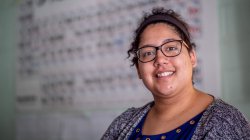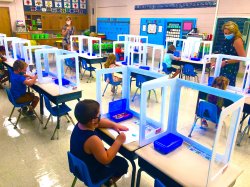Lessons from the Pandemic
Teachers say they will keep bonds formed during the pandemic when schools return to ‘normal’
Posted in: Education, Homepage News

During her first seven months teaching physics at East Side High School, Deliris Diaz ’19 MAT was consistently in motion, walking around the class checking in on how students were understanding concepts like gravitational forces in space. But that was before the world was turned upside down by the COVID-19 pandemic.
“I still move around,” she says of her teaching style since schools have gone virtual, “but it’s by texting, messaging, calling – all in one period now.”
The continued check-ins are essential as the challenges have been particularly hard for Diaz’s students in Newark, New Jersey. School buildings have been closed for more than a year and families have faced serious economic and health tolls. Students have struggled with a range of issues, from internet bandwidth and engagement to higher absenteeism and distraction.
“This past year, everyone has had to pivot to both react and respond to the pandemic,” says Sumi Hagiwara, chair of Montclair State’s Department of Teaching and Learning. “In doing so, we have been reminded of our priorities: that we thrive on human connection and survive on compassion, empathy and care for others and being kind to ourselves.”
That is the lesson Diaz says she will take with her when the schools eventually transition from pandemic learning back to some kind of “normal.”
“Content will come second. Humanity comes first. We cannot teach content unless all the immediate needs of the students are met first,” Diaz says. That means connecting students with emotional and mental health services, directing students who are hungry to local food banks or community distribution centers or guiding them to resources if faced with eviction.
Diaz, whose early years of teaching are supported by the Newark Montclair Urban Teacher Residency program, says she now regularly checks in with her students. “I ask them to rate themselves on how they are doing and if they want to share more details about it. I did not do this at all last year. Now I see the benefit of why.”
At University High School in Newark, student teachers Brigit Baines and Danielle Adamkiewicz – candidates for the University’s Master of Arts in Teaching – have yet to step foot into their classroom or meet their students in person. But they, too, have learned while teaching remotely the lessons of building community and establishing trust with students.
“Student engagement levels have dropped, but at the same time, students are really opening up and leaning on us for support,” says Baines, whose clinical experience is Grade 11 Social Studies.
Remote learning has made high school a difficult transition for Adamkiewicz’s freshman English students. “These students have lost grandparents, parents, relatives,” she says. “In a virtual environment, you’re dealing with a feeling of isolation because you can’t actually see friends, and on top of the grief, you’re still learning how to manage your time, hold yourself accountable and come up with a routine that makes sense for you as an individual. We are asking a lot of our adolescents and I think a lot of them are having a hard time with it.”
Hagiwara adds, “A lesson learned from the pandemic is that socioemotional strength is real and needs to be cultivated by not losing sight of these priorities and that we need to do what we can to preserve them.”

In rural Sussex County, New Jersey, where the kindergarten through sixth grade Sandyston-Walpack Consolidated School District has been able to offer hybrid learning since September – with staff and students wearing masks and children sitting behind plexiglass barriers and taking outdoor movement breaks – Principal Harold Abraham ’11, ’15 MA says there are also lessons that students will take with them when school returns to “normal.”
“They have come to learn that their teachers, their administrators, their parents all want for them to do well academically, but also to be strong socially and emotionally – that’s equally as important. We want our kids to be happy. That’s when ultimately they learn best, feel good about themselves and have good relationships.”
Story by Staff Writer Marilyn Joyce Lehren
You May Also Like:
